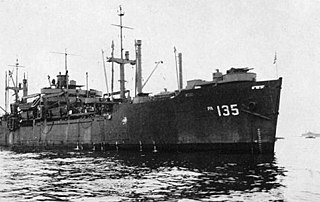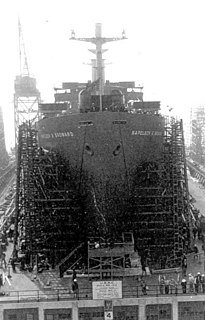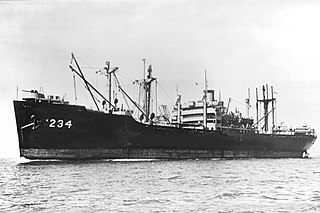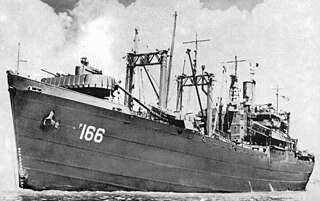
USS Lyon (AP-71) was a type C3 ship of the United States Navy which played an extensive role in naval transportation during World War II. The Lyon was built as Mormactide under a Maritime Commission (MC) contract by the Ingalls Shipbuilding Company of Pascagoula, Mississippi. She was laid down 21 August 1939, and was launched on 12 October 1940; sponsored by Gloria McGehee.

USS Zebra (AKN-5) was an Indus-class net cargo ship in the service of the United States Navy in World War II. The ship was originally the Matthew Lyon, an EC2-S-C1 Liberty ship, operated for the War Shipping Administration (WSA) as a cargo vessel by an agent until severely damaged by torpedo in August 1943. While at Espiritu Santo in the New Hebrides awaiting likely scrapping the Navy acquired the vessel under bareboat charter to be used as a net cargo ship transporting reclaimed anti-submarine netting.

USS Leo (AKA-60), an Andromeda-class attack cargo ship, was named for the constellation Leo. She is the only ship of the United States Navy to hold this name. USS Leo served as a commissioned ship for 10 years and 5 months.

USS Ottawa (AKA-101) was a Tolland-class attack cargo ship in service with the United States Navy from 1945 to 1947. She was sold into commercial service and was lost in 1951.

USS Admiral W. L. Capps (AP-121), an Admiral W. S. Benson-class transport, was the second ship of the United States Navy to be named for Rear Admiral Washington L. Capps (1864–1935). Unusually, the first — USS Capps (DD-550) — served concurrently with the Admiral W. L. Capps. Via a transfer to the United States Army and then back to the Navy, the ship was renamed USNS General Hugh J. Gaffey (T-AP-121), making her the only ship to be named for Hugh Joseph Gaffey.

USS Sherburne (APA-205) was a US Navy Haskell-class attack transport, built and used during World War II. She was of the VC2-S-AP5 Victory ship design type. Sherburne was named for Sherburne County, Minnesota. She was later converted and renamed USS Range Sentinel (AGM-22), a missile range instrumentation ship.

USS Arenac (APA-128) was a Haskell-class attack transport in service with the United States Navy from 1945 to 1946. She was scrapped in 1974.

USS Bosque (APA-135) was a Haskell-class attack transport in service with the United States Navy from 1944 to 1946. She was scrapped in 1973.
USS Signet (AM-302) was an Admirable-class minesweeper built for the United States Navy during World War II. She received four battle stars during World War II. She was decommissioned in December 1945 and placed in reserve. In February 1955, while still in reserve, her hull number was changed from AM-302 to MSF-302, but she was not reactivated. She was transferred to the Dominican Republic in January 1965 and renamed Tortuguero (BM455). She was employed as a patrol vessel in Dominican Navy service. Her pennant number was changed from BM455 to C455 in 1995. Tortuguero was stricken and hulked in 1997.

USS Auriga (AK-98) was an Auriga-class cargo ship, the only ship in her class, commissioned by the U.S. Navy for service in World War II, named after the constellation Auriga. She was responsible for delivering troops, goods and equipment to locations in the war zone.

USS Matar (AK-119) was a Crater-class cargo ship, converted from a Liberty Ship, commissioned by the US Navy for service in World War II. She was first named after Napoleon B. Broward, an American river pilot, captain, and politician; he was elected as the 19th Governor of the US state of Florida. She was renamed and commissioned after Matar, a binary star in the constellation of Pegasus. She was responsible for delivering troops, goods and equipment to locations in the war zone.

USS Allegan (AK-225) was a Crater-class cargo ship commissioned by the U.S. Navy for service in World War II. She was responsible for delivering troops, goods and equipment to locations in the war zone.

USS Rockingham (APA/LPA-229) was a Haskell-class attack transport in service with the United States Navy from 1944 to 1947. She was scrapped in 1979.

USS Bergen (APA-150) was a Haskell-class attack transport in service with the United States Navy from 1944 to 1946. She was scrapped in 1973.

USS Lauderdale (APA-179/LPA-179) was a Haskell-class attack transport acquired by the U.S. Navy during World War II for the task of transporting troops to and from combat areas.

USS Goshen (APA-108) was a Bayfield class attack transport in service with the United States Navy from 1944 to 1946. She was sold into commercial service in 1947 and was scrapped in 1973.

USS Bucyrus Victory (AK-234) was a Boulder Victory-class cargo ship acquired by the U.S. Navy during World War II. She served in the Pacific Ocean theatre of operations through the end of the war, earning one battle star, and then returned to the United States for disposal.
USS Winged Arrow (AP-170) was a La Salle-class transport of the United States Navy. The La Salle class transport had a displacement of almost 14,000 long tons (14,000 t) and were designed to ferry troops and supplies to and from the war zone during World War II.
Aloha State built by Western Pipe and Steel Company, San Francisco, as Sea Snipe for the United States Maritime Commission as a standard Type C3-S-A2 transport ship. The ship was one of the first of the standard vessels modified into a troop transport. Sea Snipe was completed 29 May 1943 and delivered to the War Shipping Administration (WSA) upon completion. American President Lines operated the ship throughout the war under a WSA agreement. The ship, after brief charter to the British Ministry of War Transport in 1946 and lay up in 1947 served as a civilian transport ship for 24 years, first as Edward Luckenbach for Luckenbach Steamship Company then Aloha State for States Marine Lines. The ship was scrapped in August 1971.

SS Meteor was built by the Moore Drydock Co. in Oakland, CA in 1943, and upon completion of construction was pressed into service as a War Shipping Administration (WSA) troop transport vessel. The ship was operated by Mississippi Shipping Company as agents for WSA. It transported troops throughout the Pacific Ocean from 1943 through 1945. It traveled from California to locations such as Hawaii, Eniwetok, Ulithi, Okinawa, Saipan and Guam, among others.

















